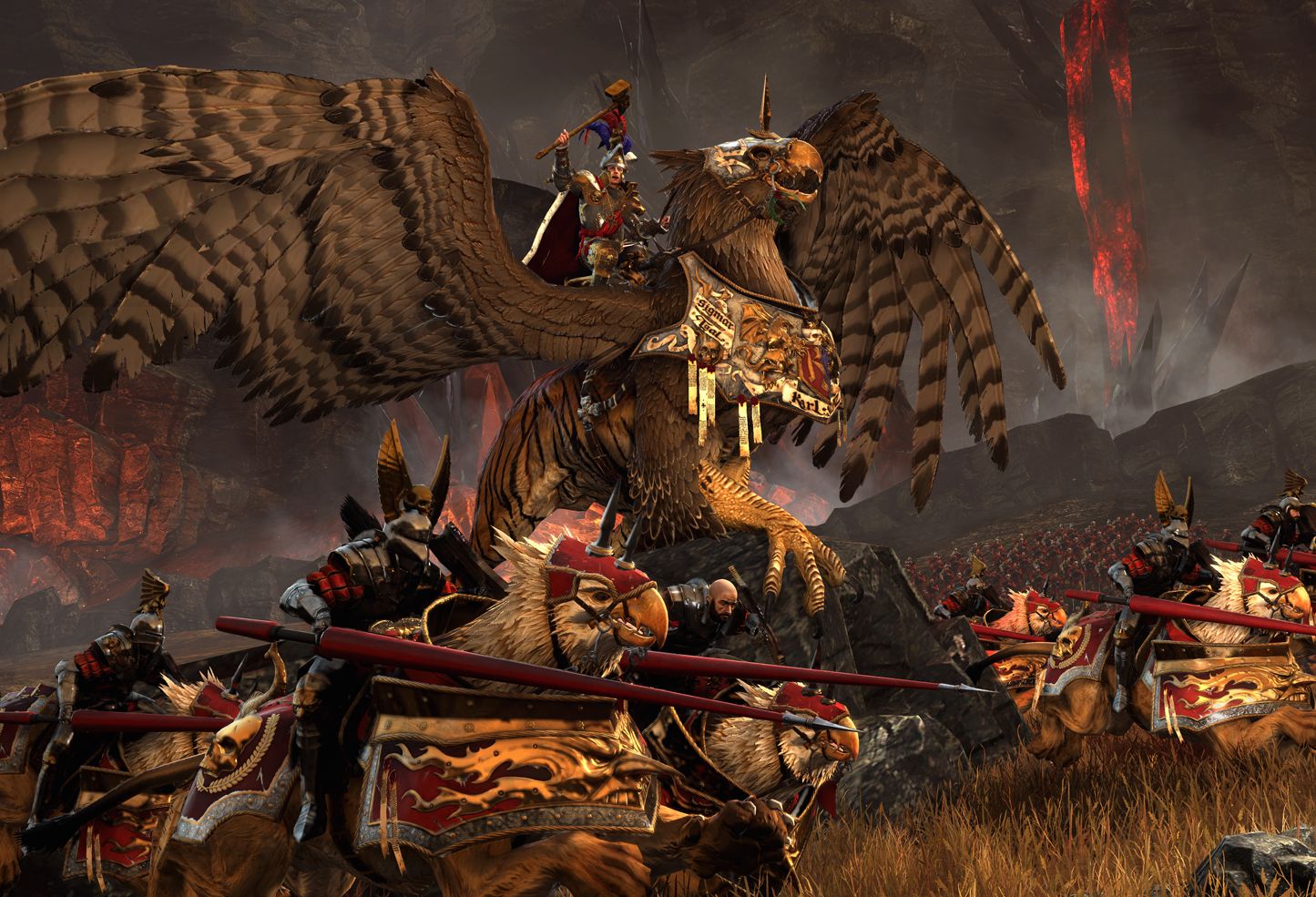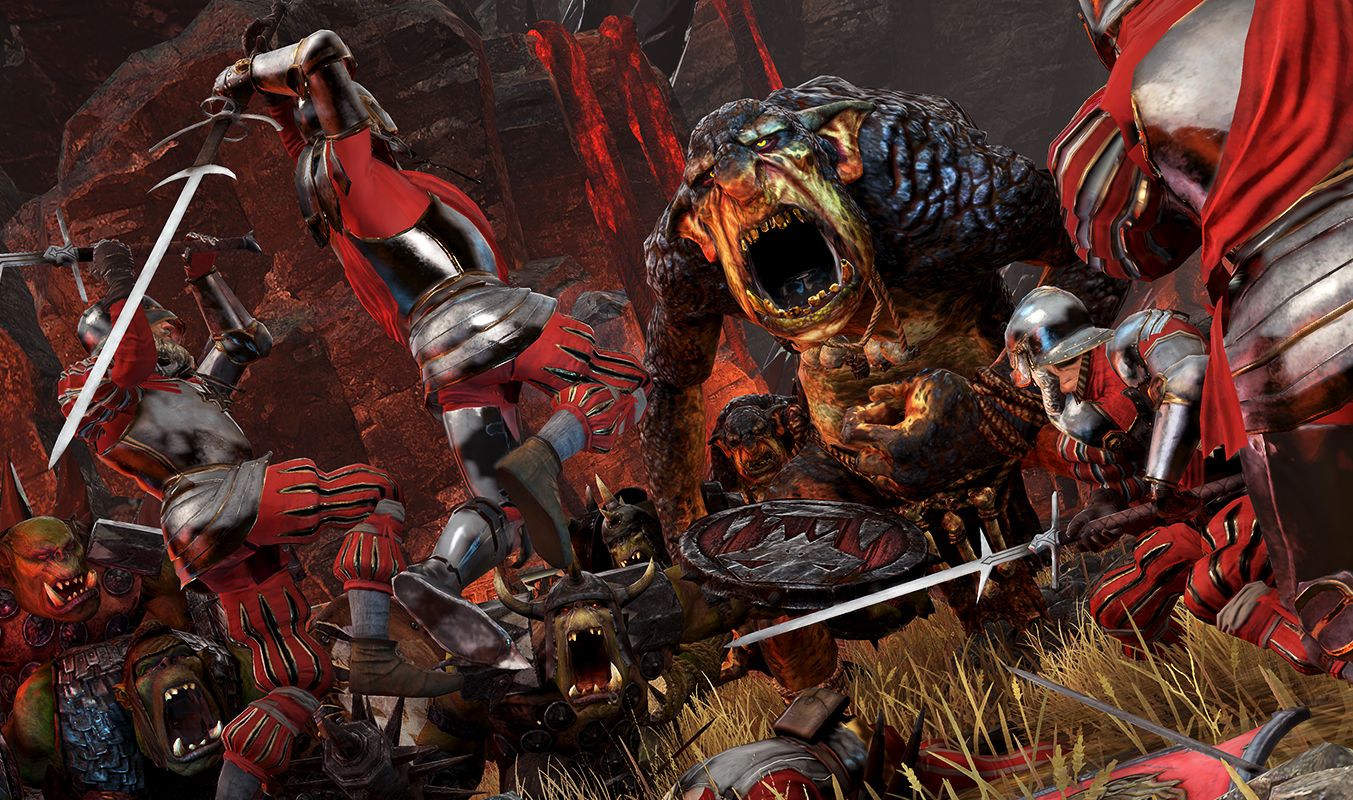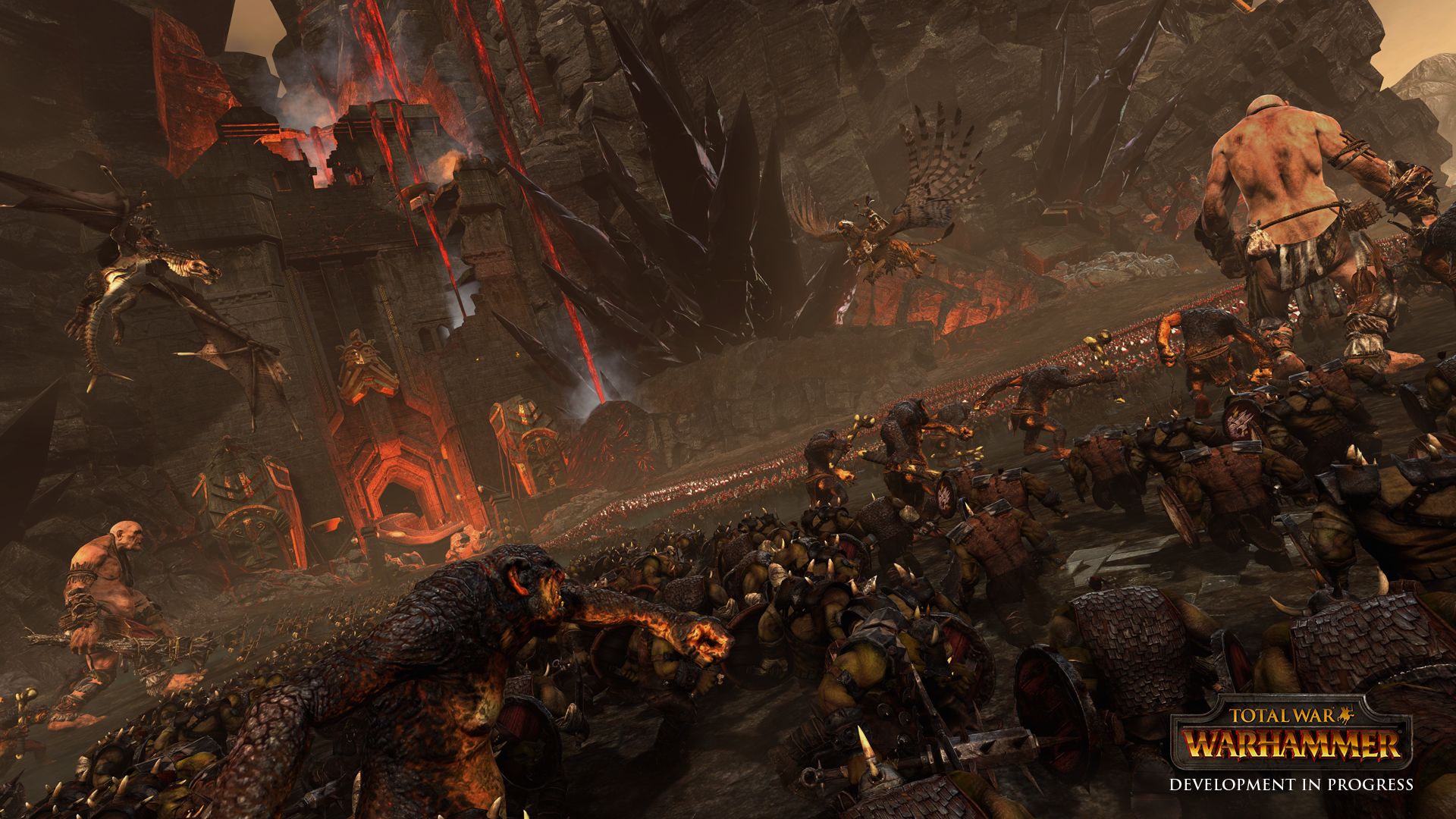Total War: Warhammer - heroes, quests, mounts and magic

This article was originally published in PC Gamer issue 280. For more quality articles about all things PC gaming, you can subscribe now in the UK and the US.
It’s a sight I’ve been dreaming about since the pixelated days of Dark Omen and Shadow of the Horned Rat. A mammoth pair of Warhammer armies battling across a sprawling Total War battlefield.
On one side, the Empire: featherhelmed humans wielding arquebuses, halberds and swords, backed up by cannons and wizards. On the other, hulking orcs and tiny goblins, variously smeared with war paint, riding spiders, wolves and boars, and reinforced by trolls, wyverns, and giants. On either side of the wide pass, lava drools from mountain crags more than two hundred feet high.
As the battle starts, the Emperor Karl Franz makes a speech from the back of his griffin Deathclaw, promising that if his troops win this battle, he’ll take up the fabled Hammer of Sigmar. It’s a longwinded monologue much like the Rome: Total War pre-battle speeches, and even the Games Workshop appointed loremaster admits “that one’s too long.” Indeed, on the other side of the battlefield, the legendary Black Orc warboss Grimgor Ironhide and his Immortals look rather bored. A low chant seems to emanate from the orc ranks.
With the oratory out of the way, the two armies rush toward one another. I’m shown various clashes—Orc Boys leaping into battle with Empire Halberdiers, Demigryph Knights bounding into Savage Orc Boarboys, Forest Goblin Spider Riders and Arachnarok Spiders literally eating their way through the Imperial Greatswords, Goblin Wolfriders charging like the Light Brigade into massed cannons, volley guns and rocket fire, and trolls vomiting acid lugubriously onto the unfortunate, frantically-firing ranks of handgunners.
Forest Goblin Spider Riders and Arachnarok Spiders literally eat their way through the Imperial Greatswords.
Of course, this new game can’t be completely accurate to the tabletop. It has to do that Dawn of War thing where it combines accurate game mechanics with outrageous bombastic battle scenes. So large units such as trolls do area attack strikes, much like Total War’s elephants, which send the Empire’s swordsmen flying. “There’s a lot of work we’ve done on the animations, to make the combat seem more dynamic and responsive,” project lead Ian Roxburgh tells me. “The sheer amount of animation is huge—even down to the amount of different skeletons, thirty types as opposed to five or six in previous Total War games.” We see a giant demonstrate this, picking one soldier up to bite his head off. Apparently, this giant can also dash his enemies against the ground, sweep with his massive club, and belch to devastating effect.
Amid the masses, infantry heroes—a Witch Hunter, a Warrior Priest of Sigmar, Grimgor—contribute to the grim carnage, while the mounted wizards and shamans hang back. A delicate wizardly war machine, the Luminark of Hysh, knocks down a towering giant like a coconut at a shy. Above everything circle wyverns and Deathclaw, dogfighting like gypsy moths.
The biggest gaming news, reviews and hardware deals
Keep up to date with the most important stories and the best deals, as picked by the PC Gamer team.

Flight is something new to Total War. “Air-to-air is obviously something we’re still working on,” Roxburgh tells me as we see Deathclaw down one of the wyverns. The griffin progresses to attacking Grimgor’s Black Orcs, whirling them up into the air before dropping them at the peak of a loopthe-loop. They rarely survive.
From every angle, it looks like the miniatures come to life, much like Dawn of War did for Warhammer 40,000. “It’s a Total War game, y’know,” says Al Bickham, studio comms manager, Ogre Kingdoms wiz and former PC Gamer contributor. “A grand campaign game, with huge, thrilling battles many of thousands of troops on the battlefields, married to Warhammer. It brings to life a spectacle that nobody has attempted before in a Warhammer game.”
Though it looks like Warhammer, I can’t play it yet—indeed, even the developers mostly aren’t playing it, admitting this is an alpha, and more a scripted sequence of events than anything like a game yet. Though Bickham, Ogre Kingdoms player, does demonstrate that at least the Goblin Doom Diver catapults are fully working, as he flings a batwinged goblin fanatic into the air and steers it across the endless Empire ranks before diving its spiked head into the densest imperial formation he can see.
One thing is notable—the scale. There are hundreds of fighters on screen here. At a rough estimate, the cost of each of the armies would be at least a thousand pounds (if you bought it from Games Workshop rather than high-quality knock-offs), probably more, even with today’s plastic figures. Very few people play with armies this size anyway—playing the Total War version rather than buying the figures is definitely going to be more economical. And much, much easier to set up.
It’s certainly comprehensive. I was lost trying to count the number of different unit types on the battlefield. “There are still other units we haven’t put in to that particular battle,” Roxburgh says. “The amount of variety we have per race is just massive. Within any race there’s more variety than within the totality of any previous Total War game.” The units in this battle were a mix of the low- and high-tier units unlocked later in the campaign.
And that’s just these two factions. I’m well aware that at least two more are coming. The Vampire Counts are one of the undead factions, which has a variety of weak skeleton and zombie and superpowered vampires, all of whom are immune to fear and morale checks. Which is handy, given how many giant, scary soldiers the orcs have.

The other race is the Dwarfs, who are even more cannon-heavy than the Empire, with an array of gadgets such as gyrocopters and flame cannons alongside slow, tough warriors like the Longbeards and Trollslayers. Roxburgh explains: “there’s a smattering of other minor races, which we’re not talking about yet, but they occupy the world as well. There’s not just four different races and that’s all.” Bickham chimes in: “you can’t have a Warhammer game without Chaos. It’s the cornerstone of our IP. Khorneerstone.” There’s a groan.
Diplomacy might have to change from the old Total War model, given the lack of connection or communication between the Warhammer factions. “The nature of the Warhammer franchise is that there are certain relationships that you can’t see changing,” Roxburgh says. “Chaos and Elves for example. But in a sandbox environment, if you really work hard on it, there’s nothing to say you have to be at war with the Greenskins all the time, you might be able to broker some dubious peace temporarily—but that’s not something you just do run of the mill. We want to be true to what those relationships are, but we don’t want to pull people into a linear game where they’ve got no choice. It’s finding that balance, while maintaining that flavour.”
You can’t have a Warhammer game without Chaos. It’s the cornerstone of our IP. Khorneerstone.
The campaign map, which they’re not showing today, will be something completely new to Warhammer, set in the Old World in a non-specific timeline. Writer / loremaster Andy Hall explains that, though turns pass, no real time does. There isn’t even weather. It’s like living in a perfect instant of Warhammer. “There aren’t seasons in the Warhammer world anyway. One day it’s raining teeth... the next, the sun’s under the sea.”
Anyway, it’s in this timeless instant that you build units, presumably from your cities, though each faction will behave in a different way. “There’s a wider variety, not just in the tactics and unit rosters, but the way we use the features in the campaign game. For example, if you’re the Greenskins, you’re not going to be spending much time building, you’ll be fighting enough battles to build up enough momentum for a Waaagh.”

